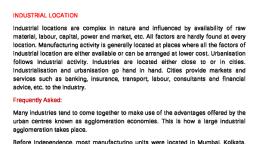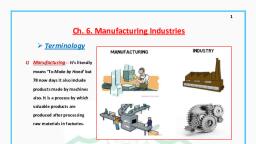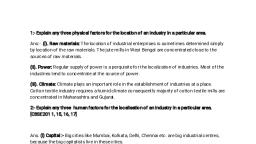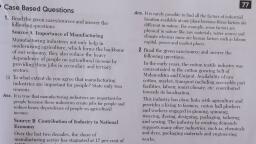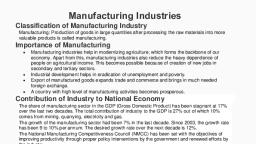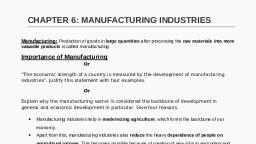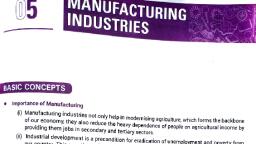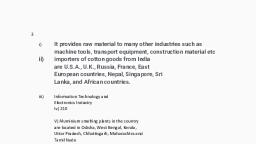Page 1 :
MANUFACTURING INDUSTRIES, , This chapter focuses mainly upon the manufacturing activities that various industries of the country indulge, in. Production of goods in large quantities after processing from raw materials to more valuable products is, called manufacturing. Manufacturing industries help drive the economy of the country and are responsible, for the country's prosperity. It also talks about different kinds of industries- their classification with, examples. Environmental degradation and pollution as a consequence of these industries has also been, discussed along with suggestions on how to prevent them., , MANUFACTURING, , Production of goods in large quantities after processing from raw materials to more valuable products is, called manufacturing. Paper is manufactured from wood, sugar from sugarcane, iron and steel from iron ore, and aluminum from bauxite. Some types of clothes are manufactured from yarn which is an industrial, product., , People employed in the secondary activities manufacture and process the primary materials into finished, goods. This sector includes workers employed in steel factories, cars, breweries, textile industries, bakeries, etc., , The economic strength of a country is measured by the development of manufacturing industries., Manufacturing sector is the backbone of country’s development because:, , (1) Manufacturing industries modernise agriculture and reduce the heavy dependence of people on, agricultural income since it provides jobs in the secondary and tertiary sectors., , (2) Industrial development is a precondition for eradication of unemployment and poverty from India. This, became the underlying philosophy of public sector industries and joint sector ventures in India. It also helps, in reducing the regional disparities by establishing industries in tribal and backward areas., , (3) Export of manufactured goods expands trade and commerce and helps bring in foreign exchange., , (4) Manufacturing products from raw materials brings prosperity to a country. India’s prosperity lies in, increasing and diversifying its manufacturing industries quickly., , Frequently Asked Agriculture and industry move hand in hand and are inclusive of each other. Agroindustries in India raise the productivity of agriculture. Agro-Industries depend upon agriculture for raw, materials and also sell their finished products such as irrigation pumps, fertilisers, insecticides, pesticides,, plastic and PVC pipes, machines and tools, etc. to the farmers., , Development and competitiveness of the manufacturing industry has helped agriculturists in increasing, their production, also making the production processes very efficient. Our industry needs to be more, efficient and competitive apart from being self sufficient., , To compete with international markets, goods manufactured by our industries must be of equal standards, to those produced in international markets., CONTRIBUTION OF INDUSTRY TO NATIONAL ECONOMY, , In the recent past, the manufacturing sector has stagnated at 17 per cent of GDP — out of a total of 27 per, cent for the industry which includes 10 per cent for mining, quarrying, electricity and gas., , In some East Asian economies, this figure is 25-35 per cent. Growth rate in manufacturing over the last, decade has been around 7 per cent per annum as opposed to the desired growth rate for the next decade is, 12 per cent., , Since 2003, the manufacturing sector has been growing at the rate of 9-10 per cent per annum. With, appropriate policy interventions by the government and renewed efforts by the industry to improve, productivity, economists predict that manufacturing can achieve this growth by next decade., , Important The National Manufacturing Competitiveness Council (NMCC) has been set up to improve the, productivity of the manufacturing sector.
Page 2 :
IMPORTANT QUESTION, , Question- What is manufacturing, , Answer, , Production of goods in large quantities after processing from raw materials to more valuable products is, called manufacturing, , Question- What is the manufacturing sector? Why is it considered the backbone of development? Interpret, the reason., , Answer, , Production of goods in large quantities after processing from raw materials to more valuable products is, called manufacturing., , It is considered as backbone of development because:, , 1) It not only helps in modernising agriculture but also forms the backbone of our economy., , 2) Industrial development is a precondition for an eradication of unemployment and poverty from our, country., , 3) Export of manufactured goods expands trade and commerce., , 4) Countries that transform their raw materials into a wide variety of finished goods of higher value are, prosperous., , Question- "Agriculture’ and ‘industry’ are complementary to each other." explain with 5 examples., , Answer, , Agriculture and industry in India are inspirable or interdependent on each other., , (1) Agro-Industries in India have boosted agriculture by raising its productivity., (2) Industries depend on agriculture for their raw materials, for example, cotton textile industry., , (3) Industries provide many agricultural and inputs like irrigation pumps, fertilizers, insecticides, PVC, pipes, machines and tools, etc. To the farmers., , (4) Manufacturing industries have assisted agriculturists to increase their production and also made the, production process very efficient., , (5) Development of different modes of transport by industrial sector has not only helped farmers to obtain, agricultural inputs but also helped them trade their products., , Question- Describe the Contribution of industry to the national economy., , Answer, , (i) Over the last two decades, the share of manufacturing sector has stagnated to 17 per cent of the GDP,, which is required to be increased., , (ii) The trend of growth rate in manufacturing over the last decade is around 7 per cent per annum,, whereas the desired growth rate is 12 per cent., , (iii) Since 2003, manufacturing is once again growing at the rate of 9 to 10 per cent per annum.

